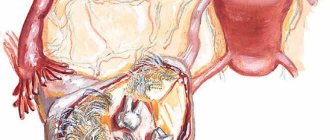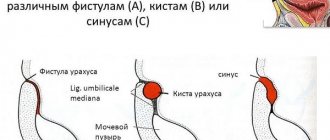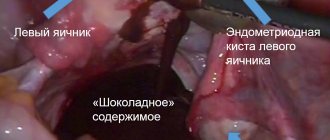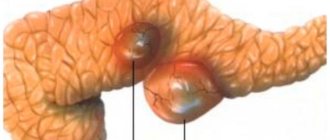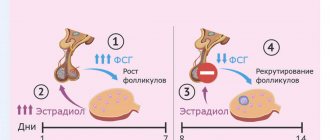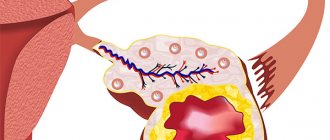A cyst in the vagina is a tumor-like formation that can be located in the vestibule of the vagina. The difference between a cyst and a dangerous malignant neoplasm is its inability to proliferate into surrounding organs and tissues.
A cyst is a developing formation that contains a cavity filled with serous fluid; as it grows, it can displace and compress the vaginal tissue and nearby organs, but does not grow into them. It can be felt at the entrance to the vagina.
What is a cyst
The formation in question is located on various parts of the vagina. The tumor is often found on the surface of the mucous layer or penetrates deep into the tissue. The size of the neoplasm is usually up to 3 cm; larger cysts are less common.
Externally, the formation has a round or oval shape. The consistency is elastic, it can be softer or, conversely, hard.
Traditional methods
It is necessary to start using traditional medicine recipes for treatment only with the permission of the attending physician. Women are recommended to take special sitz baths by adding certain types of products to warm water. These components include:
- Magnesium sulfate. You will need to dilute Epsom salt (2 tbsp) in a bowl with a small amount of water. Such baths are taken in the morning and also in the evening. The duration of the procedure is no more than 20 minutes. The course is 5 days. You can continue the procedures until the condition improves.
- Apple cider vinegar. A sitz bath is prepared using this ingredient, taken in an amount of 250 ml. This component is diluted in warm water. To reduce swelling, soak a cotton pad in vinegar and apply it to the tumor for half an hour. Procedures should be carried out twice a day.
A cyst formed in the vagina can be successfully treated with a responsible and attentive attitude to your health. Follow the doctor’s recommendations and do not take independent steps in treatment, which will avoid complications.
Causes of the disease
A neoplasm forms in the vaginal area under the influence of various provoking factors. Often the cause of the pathology is sexually transmitted diseases. In addition, the following provoking factors should be noted:
- Congenital pathologies of the vaginal structure.
- Poor hygiene.
- Chronic vaginal candidiasis.
- Inflammation of the gland of the vestibule of the vagina.
- Infectious diseases - gonococci, trichomoniasis, chlamydia.
- Injuries to the vagina during childbirth.
- Carrying out abortions and other medical procedures.
Sometimes it is not possible to determine the exact cause of the tumor. The difficulty of diagnosis lies in the fact that often the cyst occurs without visible clinical manifestations.
Suppuration and rupture of the formation pose a danger to a woman’s health. As the infection spreads, parametritis develops - purulent inflammation of the connective tissues in the uterine area.
Etiology
We examined the primary mechanisms of cyst formation, and then we will analyze where such pathologies can come from. The following circumstances in a woman’s life provoke the occurrence of education:
- Anomalies of intrauterine development;
- Injuries from rough sexual contact and other actions leading to the occurrence of a hematoma;
- Damage during abortion, curettage and other gynecological manipulations;
- Difficult childbirth with ruptures and subsequent suturing in the vagina and perineum;
- Infections of the genitourinary organs, especially those classified as sexually transmitted;
- Lack of normal hygiene of the intimate area.
Fact! Among the prerequisites, the first place is occupied by trauma to the perineum and vagina. Congenital defects are extremely rare.
Kinds
There are several types of vaginal cysts. Dermoid, follicular and luteal types do not degenerate into malignant neoplasms. Serous and mucinous gynecological cysts pose a serious danger. These types often become cancerous. The average size of the formation is up to 3-5 cm, less often 6-10 cm. In addition, the tumor is divided into several types. They can be seen in the table.
| Tumor type | Description |
| Congenital | The Müllerian ducts and Gartner's ducts take part in the formation of this form of cyst. |
| Acquired | This type of tumor appears when the vagina is injured. This most often occurs during childbirth, during uterine curettage, and also during other medical procedures. |
| Implantation | Formed on the back wall of the vagina as a result of abortion or after childbirth due to damage to the vaginal walls. |
| Retention | Develops against the background of the development of the inflammatory process of the Bartholin gland. |
You may be interested in: How to find out if you are pregnant or not at home in the early stages without a test
To make a diagnosis and determine the type of disease, a woman should make an appointment with a gynecologist and undergo the necessary examination methods.
You may be interested in reading about other gynecological diseases. All the necessary information is in one of our articles.
Diagnostic procedures
The cyst is diagnosed during an examination by a gynecologist using auxiliary instruments. A transvaginal ultrasound is performed. Be sure to purchase a special gynecological kit. The cyst is also detected during a routine ultrasound.
The first and most important point is to question the patient for complaints. The severity of symptoms will help determine the extent of the disease. Mandatory procedures include passing general urine and blood tests. A bacterial smear of the vagina is also taken for testing.
When this diagnosis is established, girls and women must visit a proctologist and urologist to exclude and prevent other concomitant diseases.
Failure to diagnose a cyst in a timely manner can cause infection of the vaginal tissue. Purulent inflammations will be cystic in nature. Severe pain can occur as a result of the bursting of the soft-elastic or tight-elastic tissue of the bag. After treatment, the pathology relapses.
Clinical manifestations of pathology
Sometimes it happens that a woman has no symptoms. This is most often explained by the early stage of the disease. In other cases, the symptoms of a vaginal cyst depend on the characteristics of the course of the disease, in particular, on the size of the tumor and its location.
The pathology clinic is as follows:
- Feeling as if there is a foreign object in the vagina.
- Painful trips to the toilet.
- Intestinal dysfunction.
- Whitish or purulent discharge.
- Increase in general body temperature.
- Painful periods.
- Pain in the lower abdomen, aggravated by sex and physical activity.
Exacerbation of symptoms is observed with viral diseases of the respiratory organs, in case of hypothermia, and also after drinking alcoholic beverages.
Vaginal vestibule cyst
The vestibule of the vagina is located close to the exit. When palpated, a woman can even detect swelling on her own.
This type of pathology can occur without any symptoms for a long time. Clinical manifestations begin to bother the patient if the compaction reaches a large size.
Cyst on the vaginal wall
Often, a neoplasm located on the vaginal wall is congenital. Pathology in a girl develops in the womb due to fluctuations in hormones and some other provoking factors. This tumor is located on the anterior or posterior wall of the organ. It is difficult to diagnose the disease yourself. Instrumental methods are required to make a diagnosis.
Symptoms and signs of a tumor: how to detect
As medical statistics in the field of gynecology show, vaginal cysts, unless they are particularly large in size, rarely show any specific manifestations. If a woman does not have regular intimate life, the presence of a tumor will most likely be determined only during a routine gynecological examination.
Naturally, if the size of the formation reaches more than 10 centimeters, the woman feels discomfort and the presence of a foreign body in the vagina. During sexual intercourse, sharp pain occurs. In addition, the growth of the cyst may be accompanied by impaired defecation due to compression of the rectum, as well as dysuric disorders.
If the covers of the cyst are subject to the appearance of ulcers, and its contents become infected with pathogenic microorganisms and begin to fester, the affected person feels increased pain, not only during sexual intercourse. She also has signs of colpitis:
- burning and itching in the vagina;
- heaviness in the lower abdomen;
- spotting not associated with menstruation;
- redness of the organ mucosa;
- purulent discharge.
Vaginal cyst during pregnancy
If a pathology is detected in a woman carrying a baby, the gynecologist, as a rule, chooses observational tactics. In this case, vitamin and immunostimulating drugs can be used. When the tumor reaches a large size, the patient may be offered puncture aspiration. In this case, the contents of the seal are sucked out with a special medical instrument.
Since aspiration of the contents of the cyst often causes relapses, after the birth of the baby, the woman is advised to undergo a full-fledged surgical intervention to remove the tumor.
Selection of a clinic
You should take seriously the choice of the clinic where you want to undergo surgical removal of a vaginal cyst. Choose only qualified specialists with extensive experience in carrying out such operations. Experts offer little-known and effective treatment methods. The price must correspond to the quality. The main goal is to work for results, the patient’s speedy recovery.
The location of the hospital and operating rooms plays a big role. It is necessary to have modern equipment for performing operations and all types of diagnostics. A sufficient number of medical workers to ensure control of the rehabilitation period. Availability of comfortable beds and comfortable conditions for hospital stay.
Possible complications
When the tumor is located in the area of the vaginal opening, the disease is often complicated by suppuration, abscess, and increased body temperature. In this case, the woman experiences general intoxication of the body. Its manifestations include:
- Headache.
- Nausea.
- Lower abdominal pain.
- Weakness, apathy, malaise.
- Dizziness.
If the cyst is located in the posterior wall of the vagina, clinical manifestations may be absent for a long time. As the tumor increases in size, the symptoms intensify and acquire the same character as the symptoms of a cyst located at the entrance to the vagina.
Some types of pathology in question tend to degenerate into malignant tumors. This applies to serous formations. When cancer develops, clinical manifestations are as follows:
- Pain during bowel movements and urination.
- Fatigue, weakness.
- The lump can be felt through the abdominal cavity.
- The patient loses her appetite and loses weight.
- The general body temperature rises to 38°C.
- The appearance of pathological discharge that has an atypical color and smell.
- Irregularity of the menstrual cycle.
- Frequent urination.
- Digestive dysfunction.
You might be interested in: Cervix by week during pregnancy
To prevent the development of complications, it is important to diagnose the formation in a timely manner and begin its treatment. According to medical statistics, if the problem is detected early, it can be dealt with without complications for women’s health.
Home Remedies
When treating with folk remedies, you need to understand that the use of herbs and medicinal substances is permissible only after the recommendation of the attending physician, since many of them may be contraindicated in case of concomitant diseases (cholelithiasis, hypertension, increased blood viscosity, high allergic status). In women expecting a baby, many herbs can cause miscarriage.
Warming procedures should not be used at the stage of cyst inflammation.
Folk remedies themselves cannot cure a cyst, but they help restore the vaginal microflora and destroy pathogenic organisms, thereby preventing inflammation.
The most commonly used are decoctions and infusions based on golden mustache, burdock, chaga, celandine and milk, cabbage juice, wormwood, string, St. John's wort, sage, chamomile and yarrow.
Diagnostics
It often happens that a vaginal cyst is discovered in a patient by chance during a routine examination or during treatment of other gynecological diseases. This is due to the widespread asymptomatic course of the pathology.
To identify a lump and make a diagnosis, a woman is prescribed the following diagnostic methods:
- Ultrasound examination of the pelvic organs.
- Colposcopy.
- Examination of a smear for bacteriological flora.
- Microscopic examination.
- General blood and urine analysis.
If necessary, other diagnostic methods may be required. The decision on their use is made by the attending physician, depending on previously obtained data.
Contraindications
Surgery should not be performed during menstruation. There is also a list of contraindications:
1. Bad urine and blood tests.
2. Lack or excess of platelets, leukocytes, and erythrocytes in the blood.
3. Low or elevated hemoglobin levels.
4. Severe cardiovascular insufficiency.
5. Infectious disease.
6. Drug intolerance.
7. Old age.
8. Oncology.
Treatment methods
Treatment methods for a tumor depend on its type and size. Surgery is most often used to remove the seal. In addition, drug therapy is carried out. Traditional methods of therapy provide good auxiliary results.
Surgical removal
After making a diagnosis, the gynecologist selects one of the methods of surgical treatment of the tumor for the woman.
The following methods are used:
- Puncture aspiration. During the procedure, a small puncture is made in the wall of the tumor. After this, the contents of the cyst are sucked out with a special medical syringe.
- Complete surgical intervention is radical excision. In this case, the tumor is removed along with part of the vaginal wall, and stitches are placed on the wound.
- Marsupialization. During the operation, the wall of the seal is dissected and the contents of the formation are removed. At the end, the vaginal walls are sutured.
Needle aspiration gives only a temporary effect. This type of treatment is considered minimally invasive and is typically used among pregnant women. Some time after pumping out the liquid, it appears again. With the other two methods, complications often arise. They consist of accidental damage to internal organs and suture divergence.
Expert opinion
Ksenia Dunaeva
User experience expert and comment moderator. Higher medical education and more than 5 years of actual practice.
Ask Ksenia
In some cases, the patient has contraindications to surgical intervention through the vagina. In this case, the patient is indicated for laparotomy surgery.
Drug treatment
If a vaginal cyst is detected in a timely manner and is small in size, drug therapy works effectively.
Drugs from the following groups help cure compaction:
- Anti-inflammatory drugs.
- Immunostimulating agents.
- Sedatives.
- Vitamin complexes.
- Enzyme agents.
- Antibacterial drugs.
Conservative therapy does not always give positive results. If the prescribed treatment does not give good results over several menstrual cycles, the patient is recommended to undergo surgery.
You might be interested in: Head presentation of the fetus
Folk remedies
The use of alternative medicine should be carried out only after consultation with your doctor. Sitz baths provide good results. To do this, you can use a bowl or purchase a special basin at the pharmacy. Such remedies will help relieve inflammation.
Magnesium sulfate
To prepare the solution, you need to take two tablespoons of salt per 3 liters of water. The water should be warm. The ideal temperature is 37-38°C. You need to sit in the resulting solution for 15-20 minutes twice throughout the day. The duration of treatment should be at least 7-10 days.
Women with infectious and inflammatory diseases in the pelvic area should be treated with caution.
Vinegar
To prepare the solution, use apple cider vinegar. For 3 liters of water you need to take a glass of vinegar. You can also use vinegar compresses on the area of the lump if it is close to the vaginal opening.
To prepare a compress, you need to take a tablespoon of vinegar in half a glass of water. Compress time is 15-20 minutes.
Aloe based ointment
To prepare the ointment, you need to take about 2 tablespoons of fresh aloe pulp and mix the product with the same amount of baby cream or Vaseline. The resulting paste should be applied to the affected area up to 4 times a day. You can generously treat the seal overnight. Before using aloe, you should make sure that you are not allergic to this plant. To do this, apply a little aloe to your wrist and wait 15 minutes. If the skin is not red, you can use the product.
To enhance the effectiveness of your homemade ointment, you can add a teaspoon of honey to it. This product has anti-inflammatory and antiseptic effects.
Herbal decoction
To ease general well-being and strengthen the immune system, it is recommended to take herbal decoctions. Preference should be given to anti-inflammatory and immunostimulating plants. Herbs such as chamomile, sage, thyme, yarrow, and calendula are suitable. You can take herbal decoctions from several types of plants at the same time.
To prepare the decoction, you need to take a tablespoon of herb per half liter of boiling water. The product is brought to a boil and simmered in a water bath for at least 15 minutes. After this, remove the broth from the heat and allow it to cool. You need to take the medicine in the morning and evening before meals, half a glass.
Rehabilitation
The period of rehabilitation and therapy is short. Healing and resorption of sutures occurs quickly. The woman has been in the hospital for a couple of days. Next, as you feel better and have the doctor’s permission, you can switch to a day hospital.
Already after 2-3 days, movement is allowed. Without making sudden movements or bending. Do not lift heavy objects. Within a month, the menstrual cycle is restored. Supportive housing may be worn after surgery.
The seams are treated with antiseptic solutions to prevent infection. Do not drink alcoholic beverages and stop smoking. Do not take vasodilators.
Disease prevention
A woman should adhere to preventive measures even while carrying her daughter, so that after the birth of a girl she does not have such a congenital disease as a vaginal cyst. In addition, prevention methods include:
- Rejection of bad habits.
- Proper nutrition.
- Maintaining a proper daily routine and sufficient physical activity.
- Timely treatment of gynecological diseases.
- Planning for a baby and proper management of pregnancy.
- Compliance with all doctor's recommendations after childbirth.
- Refusal of abortion.
- Selectivity in sexual life.
These and other preventative measures will help prevent disease and maintain health. We wish our readers good luck in everything and good health.
All information provided in our article is for informational purposes only and cannot be regarded as a call for self-treatment.
Postoperative period
After surgery to remove a vaginal cyst, you must adhere to the specialist’s instructions. In order for the tissues to recover and complete rehabilitation of the body to occur, the doctor may prescribe a certain list of medications. The patient’s task is to observe the frequency of doses and complete the full course of treatment.
For pathology therapy to be as effective as possible, the patient must:
- Do not use hygienic tampons and avoid sexual intercourse until tissue regeneration is complete, as infection of the epithelial tissue is likely.
- Limit serious physical activity.
- Until complete healing, do not visit saunas, steam baths, take hot baths or swim in the sea or river.
- Adhere to a special diet with limited intake of provoking foods (fried, fatty, spicy) foods.
- Eat foods rich in substances that improve the body's regenerative abilities. The doctor may prescribe medications containing these substances (tocopherol, selenium, B vitamins).




